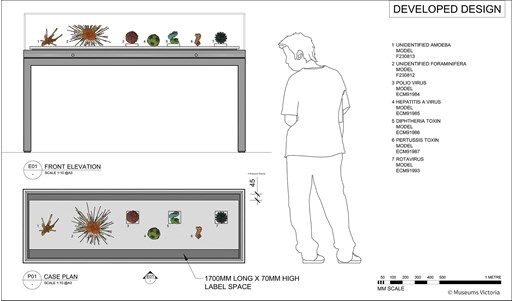3. How will you make it?
The location, look and layout of an exhibit have a huge impact on what visitors do, think and feel, and designing them takes a lot of careful planning.
Reflection
Watch Simone’s tour of her completed exhibit.
- What location, materials and layout did Simone choose?
- And how did those choices affect what a visitor might do, think or feel?
Look at these images that a Museums Victoria designer created when planning an exhibit for the Mini Mega Model Museum.
Making this plan helped the designer decide where to put each part of the exhibit, and see how it would all work together. It made the exhibit easier to build, because everything was already decided.
- Have you ever used drawings or models to plan what something will look like?
Your design
Use the following questions to start planning your design.
Where will my exhibit be?
e.g. A room at home; the corner of my classroom; on a table; stuck to the wall.
What does it need to include?
List the objects, pictures and sensory elements you have decided to include in your exhibit.
What materials could I use?
What can you use to build your exhibit? Consider recycled and reusable materials e.g. cardboard boxes, scrap paper, textas
What limits or challenges are there?
e.g. I only have one piece of cardboard; I need to complete the exhibit by Thursday; there’s not much room on the wall.
- Draw a diagram of your exhibit, showing where it will be, where each part will go, and anything extra you will make (e.g. does your object need a stand?).
- Label your diagram with the materials you will use to create different parts of the exhibit.
- Remember your visitor, and what you want them to learn and feel. How can your design support this? E.g. I will use cool, dark colours to make my exhibit feel serious.
- Check your design with someone else. Is it achievable? Will you need any help to build it?








